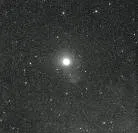Price: £398.00
Weight: 225g
Supplier: Telescope House
Telephone: 01342 837610
Website: www.telescopehouse.co.uk
Unlike most CCD cameras that have cooling fans, the Meade DSI (Deep Sky Imager) Pro II’s sensor is passively cooled using a distinctive ‘iron waffle’ heat sink to remove unwanted heat from the camera’s interior.
Although this works well and the DSI exhibits fairly low heat-induced noise, it still produces noisy raw (pre-processed) images.
However, long exposures showed that the noise was evenly distributed across the image with no unwanted gradients.
The camera comes with the Meade AutoStar Suite, which, as its name suggests, is heavily tied into Meade’s proprietary AutoStar telescope control system.
If you already have an AutoStar-controlled telescope, the DSI Pro II should be a serious consideration; the level of integration between software, camera and scope is excellent.
AutoStar Suite has everything you need to plan, capture and process your images.

There’s a planetarium program that moves an AutoStar telescope to point at whatever’s on the screen, a camera-control program called Envisage, and a well-equipped image-processing application.
The last item is especially useful if you don’t already own image-processing software and are about to embark on CCD imaging.
Nail the noise
Envisage is a clever program geared towards getting you the best image possible.
It puts a lot of emphasis on dark frames – images taken with the scope’s lens cap on, that identify any noise present on the CCD chip.
These are essential for lowering the camera’s noise levels.
A sensor inside the camera takes the temperature of the chip and displays the data on your computer screen.
This data is also recorded against dark frames whenever they are generated.
Then, when you take an image, Envisage looks for the dark frame with the closest temperature match and subtracts it automatically to get rid of the noise – a really nice touch.
Another clever innovation is the use of a software routine called ‘Drizzle’.
This improves image resolution, increases the image dimensions and acts as a field de-rotator, as long as your telescope is controlled by AutoStar.
The field de-rotator corrects the star trailing that occurs when using an altaz mount which, by default, doesn’t mimic the natural rotation of the sky.
It may also help if you’re using an equatorial mount with poor polar alignment.
This is a great camera if you’re intending to start out in CCD imaging, but don’t really want to get your hands too dirty with the technicalities.
It’s also very tempting if you already have a Meade AutoStar-controlled scope, plus it can be successfully used as an auto-guider – select a target object and the software will make the scope track it.
Our main concern was the base level of noise it generated.
Despite Envisage doing a wonderful job of reducing this noise in post-capture image processing, the main thrust of CCD imaging is to collect a raw image that’s as pure and noise-free as possible.
The DSI Pro II needs a little too much help from software to achieve this.
Test images

This 600s dark frame contains significant levels of noise, but no unwanted gradients.

A detailed 120s exposure of M27, but without a software fix the raw image suffers from too much noise.

A 120s, h-alpha filtered shot of Sadr in Cygnus shows promise, but it’s masked by raw frame noise.
This review appeared in the January 2008 issue of Sky at Night Magazine